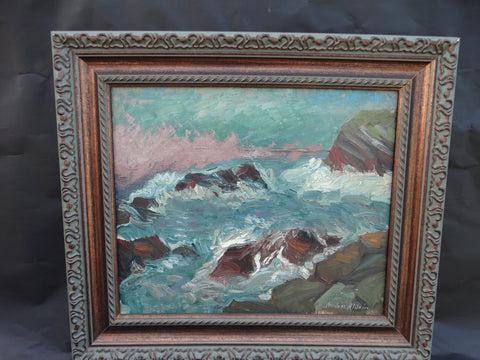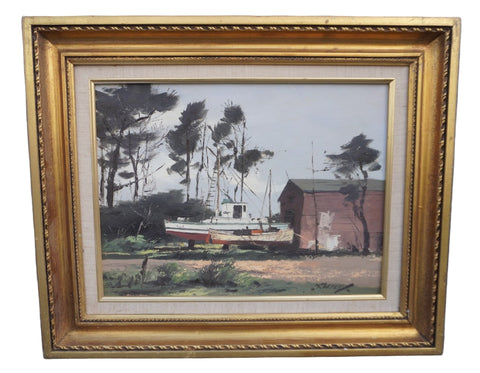J. P. McMeekin (1857-1936) Snake River Canyon Railroad Oil on Board 1884
A wonder from a painter who stayed put painting in one place until he got it right. This is how the West was won, and how one dedicated artist captured that moment. The spiritual strain in American landscape painting is fully present in this man’s work.
Framed 36″ x 27″.
Article excerpts by Arthur A. Hart, retired
Director of the State Historical Society, Boise, Idaho.
The following content is from the exhibit brochure:
Island in the Snake
The Idaho Paintings of Pioneer Artist
J.P.McMeekin
April 17-July 1, 1983
The canyon of the Snake River in southern Idaho is an awesome place. Sheer cliffs of basalt plunge hundreds of feet to tumbled ruins of rock below. The moving river that carved this canyon flows silently past, gray and lonesome, a shadow of the torrent that once roared from ancient Lake Bonneville.
To spend a day at the foot of these great walls of stone is a haunting experience. One feels lost in a hidden crack of rock on another planet, in a world without human scale.
That an artist of rare sensitivity and dedication should find himself in this elemental world of rock and water, not for a day, but for 20 years, is indeed fortuitous for us. That nearly a hundred of the sketches and paintings he made should have survived is a cause for celebration.

McMeekin at Age 19
Joseph Patrick McMeekin was born in Ireland in 1857. He came to the United States with his parents and younger sister, Sarah, in 1872. Sarah married another young Irish immigrant, Liberty Millet, and when the couple homesteaded on an island in the Snake River near Hagerman in the late 1880's, Joseph moved there too. He was determined to devote his life to art, and had already decided that Nature would be his only teacher.
During the canyon years in Idaho, and for the rest of his life in California, where he moved in 1910, McMeekin literally lived to paint. He braved snow storms, rain, and summer heat to get his images as directly from nature as he could. Family tradition has it that his singlemindedness often made him forget to eat or to rest. He never married, but remained true to a credo like that of the poet Walter Savage Landor who wrote "Nature I loved, and next to Nature, Art."












